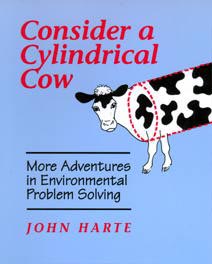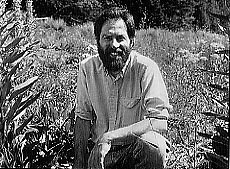
Consider a Cylindrical Cow: More Adventures in Environmental Problem Solving
Following in the tradition of Consider a Spherical Cow, the Cylindrical Cow will help students achieve a whole new level of environmental modeling and problem solving.
Summary
Following in the tradition of Consider a Spherical Cow, the Cylindrical Cow will help students achieve a whole new level of environmental modeling and problem solving. Featuring a new core set of 25 fully worked-out problems, this book uses real problems in environmental science rather than relying on the more traditional “cookbook” problems found in textbooks. It is organized according to five thematic sections on probability, optimization, scaling, differential equations, and stability & feedback. Each section begins with a general treatment of the relevant mathematical concepts, and concludes with a range of homework exercises to help students sharpen their modeling skills. Like its predecessor, this book will empower students with the mathematical skills needed to cut through the complexity of real-world problems.
Resources
Table of Contents
Preface
Acknowledgments
Chapter I PROBABILITY
Introduction
Background
Problems
1. Pick Your Poison
2. Infanticide in China?
3. Caesar’s Last Breath
4. A blot from the Blue?
5. On the Street Where You Live
Chapter II OPTIMIZATION
Introduction
Background
Problems
1. Advice for Farmers
2. Efficient Censusing
3. Blowing in the Wind
4. Haste Makes Waste
5. Biting the Hand that Feeds Us
Chapter III SCALING AND DIMENSIONAL CONSISTENCY
Introduction
Background
Problems
1. How Tall Can a Mountain Be?
2. Sleeping Bears
3. Little Green Men?
4. What a Drag
5. Saving the Species: The role of Reserve Shape
Chapter IV CORE MODELS OF CHANGE IN TIME AND SPACE
Introduction
Background
Problems
1. Pollutant Stock-and-Flow: Reconstructing CO2 Emissions
2. Population: Limits to Growth
3. Climate: Influence of Solar Variability
4. Community Ecology: Origins of Cycles
5. Biogeochemistry: Nitrogen Fertilization and the Carbon Sink
Chapter V STABILITY AND FEEDBACK
Introduction
Background
Problems
1. Stability of the Core Models
2. Some Say in Ice
3. Biting the Hand that Feeds Us (II)
4. Sagebrush World
5. Will the Seas Go Flat?
Appendix: Useful Mathematical Expressions and Approximations
Further Reading
Index
Preface
The cow is back. This time she is cylindrical, not spherical. Still no legs, udders, or head, but the torso is a more realistic shape. Following on the hooves of Consider a Spherical Cow (Harte, J. 1988. Consider a spherical cow: a course in environmental problem solving. Sausalito, CA: University Science Books) called COW-1 herein, COW-2 will teach you additional modeling skills of use in environmental science. Some of these skills are at roughly the same mathematical level as Chapters II and III of COW-1, whereas others are more advanced. Although the emphasis here, as in COW-1, is on analytic approaches to squeezing information from models, I also include spread-sheet methods for simulating the behavior of models constructed from differential equations. You will get the most out of COW-2 if you have worked through COW-1, but I have tried to make COW-2 self-contained.
I have assumed that you, the reader, are acquainted with both differential and integral calculus, though the relationship need not be lustful. Indeed, only a passionate dislike (or deep and unyielding fear) of mathematics will disqualify you from proceeding further. Some past exposure to matrices will also help; for those who need to do some remedial reading on calculus or matrix algebra, I highly recommend Clifford Swartz’s excellent Used Math (Swartz, C. E. 1993. Used math: for the first two years of college science. College Park, MD: AAPT Press).
I have also assumed that you are ready to seek out deeper insights into ways of modeling the complexities of nature, but the underlying goal is the same as in COW-1: to teach ways of stripping away inessential detail and capturing with mathematics the essentials of a complex system.
Why do I want you to learn to use mathematics? Can’t we just talk about environmental problems? There is another reason in addition to the often-expressed, and correct, argument that mathematics seems to be the “language that nature speaks” and therefore facilitates the understanding of nature. Mathematics is a kind of global language that not only needs no translation from nation to nation but also bridges the disciplines. Economists and scientists often confuse each other (and sometimes themselves) using everyday language to describe how things depend upon other things; the reason is that in the two academic traditions the same word may be used in different senses. (Consider, for example, the terms equity, parity, derivative, and stock.) Mathematics, however, has a way of cutting through such confusion.
Just as the “Tools of the Trade” chapter of COW-1 was structured around the topics of steady-state box models, thermodynamics, chemical equilibrium theory, and non-steady-state box models, COW-2 is structured around the central themes of probability, optimization, scaling, differential equations, stability, and feedback. Why these themes? Consider such problems as (a) determining how some shift in land-use practice (e.g., conversion of tropical forest to grazing land) might result in species extinction or climate alteration in the region, or (b) determining whether exposure to a trace substance released from a factory poses a serious health threat to people living nearby. In problems such as these, themes that affect our understanding and analysis of the problem can be extracted as follows:
- Much of our information about these situations comes to us in the form of data derived from some sampling scheme. We need to know something about probability and statistics to assess how representative the data are.
- We may discover that the activity leading to the environmental damage does bring some benefit to society, but that if the activity is too intense, then society is the loser. We need to know something about optimization to estimate where the balance point between societal benefits and societal costs lies.
- We may be able to determine something about the effects of a toxic substance on adults but not on children, so we need to know something about how to scale our knowledge from big people to little people. Or, to estimate species loss, we may be able to use existing data on the rate of local species extinctions from deforestation, provided, we can “scale up” to larger regions.
- We will want to predict not only the eventual long-term-averaged climate conditions that will result from the loss of forest but also the way in which climatic conditions will change over time in the shorter term as they approach that eventual state. The mathematical tools needed to predict that climate trajectory over time are differential equations. We need to know how to set up the appropriate differential equation for the problem at hand and how to find approximate solutions to that equation.
- As we alter a complex system, for example by cutting down trees, thresholds of instability may be crossed. Before the threshold is reached, the system can assimilate the stress and maintain some sort of equilibrium, but if the stress is too great, then the system may undergo a dramatic response. We need to know how to estimate whether such a threshold exists and where it lies.
- Climate changes induced by altered land-use practices can further alter ecosystems and degrade ecosystem services of benefit to society. These feedbacks may further alter human behavior as people seek to compensate for the lost ecosystem services. We need to be able to estimate the magnitude and consequences of such feedback effects.
The pervasiveness of these themes is well known to environmental scientists in fields such as climatology, ecology, hydrology, toxicology, and atmospheric chemistry. Despite this understanding among scientists, public policy debates often neglect such critical linkages and issues. The public is easily misled by twisted probabilistic reasoning. Misuse of optimization methods can lead to suboptimization (doing better and better something that would not have been done at all if the boundary of analysis had been enlarged). Analytic methods, insights, institutions, adaptations, and solutions appropriate at one scale (e.g., experimental plots in ecology, individual firms or power plants in industry, a grid square in global climate modeling) are often naively and mistakenly extrapolated to other scales. Incorrect conclusions about the distribution and fate of emitted substances usually can be spotted and corrected with the aid of approximation methods for studying solutions to differential equations. Instabilities and feedbacks, both between and within human and biophysical systems, are often ignored in political, social, and even scientific analysis, leading society to be inadequately prepared for the possible abruptness and intensity of resulting changes.
At the beginning of each of the five thematic sections in this book is a general treatment of the relevant mathematical concepts. The core of the book is 25 fully worked-out problems. As in COW-1, each problem statement is posed more like a research question than a standard homework exercise. Homework exercises follow each worked-out problem solution and range from relatively straightforward exercises that probe readers’ understanding of the concepts and methods to more difficult and open-ended research suggestions. The Appendix summarizes many useful mathematical notations and formulae you are likely to encounter.
Sample Problems
1-3. Caesar’s Last Breath
How likely is it that at least one nitrogen molecule exhaled by Caesar in his last breath will be in the next breath you take?
III-2. Sleeping Bears
True hibernators (such as many rodents) metabolize during hibernation at a rate well below half their normal basal metabolic rate. When a typical 450-kg adult Alaskan bear (Ursus arctos) emerges from its winter hibernation, it is typically about 100 kg lighter than when it entered hibernation 6 month earlier. The fat it burned off yields about 38 X 106 joules/kilogram. Is this bear a true hibernator?
V-5. Will the Seas Go Flat?
After sitting for an hour at room temperature, a glass of beer will be “flatter” than if it remained cool. Our oceans contain about 50 times as much carbon dioxide (including its dissociated ionic forms, bicarbonate and carbonate) as does the atmosphere, and thus loss of a sizeable fraction of oceanic carbon dioxide to the atmosphere could have an enormous effect on the atmospheric level of this greenhouse gas. Could the oceans go flat….?
For the answers to these problems and many more like them, sharpen your pencil! (Or get the book.)

